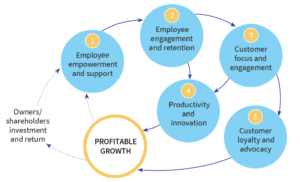Want to learn more?
Talk to us today about how to move the dial and become a high growth and high performing organisation.
Benchmarking board performance: 500 board reviews later
Unlock evidence-based insights into board performanceInsync’s paper “The 5 drivers of the Profitable Growth Cycle™ reveals the 5 factors that drive profitable growth based on our analysis involving results from almost 1,000 surveys.


As Australia manages to ride out the COVID-19 pandemic, the current global environment remains uncertain. Organisations will continue to find it difficult to achieve their financial goals amid such uncertainty and flux.
Although profitable growth is one of the top challenges facing businesses today, only a handful of organisations succeed in driving both revenue and profit growth successfully. This paper explores why profitable growth is such a challenge and what organisations need to do to get back on the path of consistently achieving the profitable growth they desire.
The external challenges facing organisations are well understood, but here we focus more on the internal challenges facing organisations. What are high growth organisations doing well? Where do they focus their efforts and investments? What does it take to build competitive advantage and thereby deliver superior results in a sustainable way?
Our research into the internal drivers of profitable growth reveals why sustainable performance is so hard to achieve. Modern organisations are complex organisms with many moving and inter-related parts. If one part of the organisation is not performing well it will impact others. There are many things that need to be in place to serve customers well and achieve superior financial results.
Based on the lessons learnt from conducting almost 500 customer surveys and over 500 employee surveys, supplemented by a thorough analysis of many research studies into this topic, we have found that high growth organisations (HGOs) have a different thought process and focus compared to low growth organisations (LGOs).
This different thinking and focus is illustrated by Insync’s Profitable Growth Cycle™.


HGOs understand that achieving profitable growth starts with their investment in their employees and how that leads to employee engagement and retention which leads to customer focus and engagement then to customer loyalty and advocacy which leads to profitable growth.
Employee engagement and retention and customer focus and engagement also leads to productivity gains and innovation which also leads to profitable growth. The framework outlines how the five factors inter-relate to drive and enable a virtuous circle of profitable growth for an organisation.
Driver 1: Employee empowerment and support refers to the need for clear direction and expectations, and the development and support of employees to enable them to do their jobs well. This leads to:
Driver 2: Employee engagement and retention. Having motivated, focused and experienced employees leads to drivers 3 and 4.
Driver 3: Customer focus and engagement. Engaged and longer serving employees build strong customer relationships and ensure robust systems are implemented to meet customer needs. This leads to:
Driver 4: Productivity and innovation. Productive employees and lower recruitment and induction costs enable competitive pricing and innovation which underpin sustainable profit margins.
Driver 5: Customer loyalty and advocacy. This results in ongoing revenues from existing customers and growing revenues from new customers.
Profitable growth is the outcome from stable and growing revenues on the one hand, and productivity gains and innovation on the other. Profitable growth is a crucial component of a virtuous cycle that enables continued investment in employee empowerment and support, and thereby reinforces and strengthens the other drivers of profitable growth.
Profitable growth also provides the required return or dividend flow to the owners of the business. In certain cases confidence in the organisation’s growth record and opportunities will promote additional investment from the owners if required to accelerate the organisation’s growth trajectory.
HGOs create a virtuous cycle that continues to build on itself over time. These organisations understand the inter-relationships in the cycle and in particular that great customer outcomes are achieved as a result of highly engaged, empowered and well supported employees.
Conversely, organisations that don’t understand or buy-in to the importance of this inter-relationship will find that their efforts are continually frustrated. These organisations are less likely to invest their time and resources appropriately, and face a real risk of being caught in a downwards spiral.
Talk to us today about how to move the dial and become a high growth and high performing organisation.
Unlock the power of employee feedback with strategic action planning. Learn to leverage voices, identify areas for improvement, and maximise buy-in with our ...
Discover the invaluable tips driving Cenitex's employee engagement and transformative enhancements in our latest case study.
Join the BoardPro Webinar, where Nicholas Barnett will discuss the crucial role of the Board Skills Matrix in the director selection process.
Explore the nuances of redeveloping or reviewing your Local Government Community Vision. Find clarity and guidance here.
We use cookies to enhance your experience. Further use is considered consent. You can read more about cookies in our Privacy Policy.


You’ll always get a real person when you contact Insync.
Let's get started